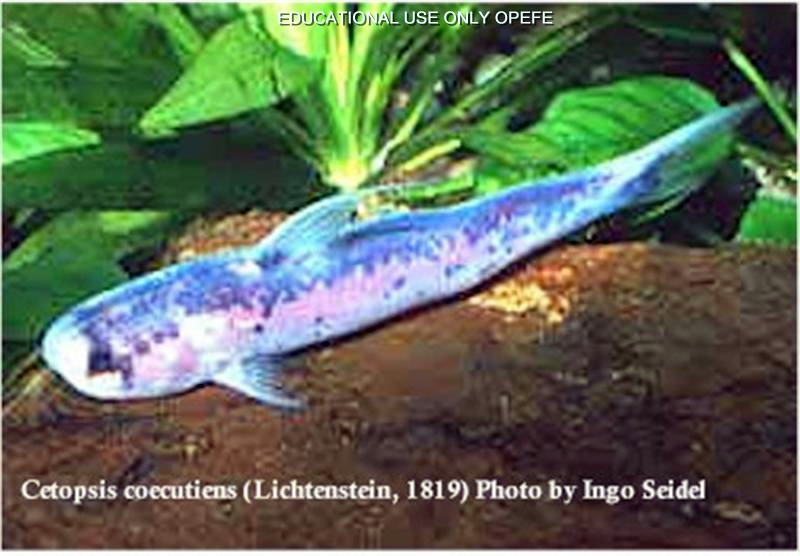 WELCOME TO OPEFE ARCHIVES
WELCOME TO OPEFE ARCHIVES
genus Ceptopsis
Cetopsidae: Cetopsinae
Blue Whale Catfish, Carnero, Bagre Azul
FROM FRANK MAGALLANES
Ceptopsis is commonly called a Peruvian Blue Whale by English-speaking people and is usually the species seen in pet store aquariums.
There are apparently a few color morphs of this species; blue, green, tiger stripped, and one called Sleep Cetopsis.The whale catfishes are restricted to mainly the northeastern area of South America (ie; Brazil, Peru, Bolivia, Colombia, Ecuador, Venezuela). They are typically found at depths ranging from 2-40m and can be found in the river channels of the Brazilian Amazon such as the rivers Amazonas and Solimoes. Although some cetopsids in the cetopsidae family have only been found at maximum lengths of 30 mm, C. coecutiens are known to grow up to 35 cm in length. Their larger size and streamline bodies (comparable to other Cetopsidae) allow whale catfishes to swim with great effectiveness in faster currents.
This species is thought to be harmless (See Dr. Warren E. Burgess, Catfishes of the World) however, I would not trust it too far. They attack fishes and carrion in fast moving surface waters. They are also known to drill holes in humans and actually eat you from the inside out. Leaving pretty much a hollow corpse. Law enforcement in areas where the fish is common would sometimes believe a person was killed by gunfire because of bullet type holes in the body. Only through autopsy would they find evidence of carnero intrusion in the hollowed out body (source Jeramy Wade, River Monsters, Animal Planet). Piranhas are largely blamed for human mortalities or injuries. But these fish known as carnero can make a piranha look harmless. There is no doubt that the carnero does indeed skeletonize humans in a feeding frenzy.
In the digestive tracts of related species of Cetopsidae such as B. oliveirai, remains of spiders, heads of ants, mosquito-like dipteran, diptera and orthopteran have been found. This suggests that Cetopsidae may have some form of terrestrial diet in addition to other fish. C. coecutiens have one row of thin, blunt, conical teeth with which they eat their prey. Cetopsidae: Cetopsinae.
VALID SPECIES LIST AND DISTRIBUTION - 2007
|
Cetopsis amphiloxa Eigenmann 1914 Pacific versant, West Colombia and nw. Ecuador
Cetopsis coecutiens Lichtenstein, 1819 Amazon, Tocantins and Orinoco river basins: Argentina, Bolivia, Brazil, Colombia, Ecuador, Peru and Venezuela.
Cetopsis oliveirai Lundberg & Rapp Py-Daniel 1994 Middle and Upper Amazon river basin: Brazil and Peru
Cetopsis plumbea Steindachner 1882 Upper Amazon river basin, NE Bolivia, E. Ecuador and SE. Peru |
Cetopsis arcana Vari, Ferraris & de Pinna 2005 Middle and upper portions of rio Tocantins basin, Brazil
Cetopsis fimbriata Vari, Ferraris & de Pinna 2005 Río Atrato basin, Caribbean versant of NW. Colombia
Cetopsis orinoco Schultz 1944 Orinoco R, basin, Colombia and Venezuela and Caribbean Sea versant of N. Venezuela
Cetopsis sandrae Vari, Ferraris & de Pinna 2005 Rio Arinos, upper portions of rio Tapajós system, Amazon basin, Brazil |
Cetopsis baudoensis Dahl 1960 Pacific versant, Baudó river basin, West Colombia
Cetopsis jurubidae Fowler 1944 Jurubidá river basin, Pacific Ocean versant, W. Colombia
Cetopsis othonops Eigenmann 1912 Magdalena and Sinú R. basins, Caribbean Sea versant, NW. Colombia
Cetopsis sarcodes Vari, Ferraris & de Pinna 2005 Rio Tocantins basin, E. Brazil |
Cetopsis caiapo Vari, Ferraris & de Pinna 2005 Tocantins basin, Brazil
Cetopsis montana Vari, Ferraris & de Pinna 2005 Western portion of Amazon basin in NE. Peru and S. Ecuador
Cetopsis parma Oliveira, Vari & Ferraris 2001 Upper Amazon river basin: Brazil, Ecuador and Peru
Cetopsis starnesi Vari, Ferraris & de Pinna 2005 Southeastern Bolivia and Argentina |
Cetopsis candiru Spix & Agassiz 1829 Amazon river basin: Bolivia, Brazil, Ecuador and Peru
Cetopsis motatanensis Schultz 1944 Lake Maracaibo basin: Colombia and Venezuela
Cetopsis pearsoni Vari, Ferraris & de Pinna 2005 Upper portion of the rio Madeira drainage basin, SE. Peru and NE. Bolivia
Cetopsis umbrosa Vari, Ferraris & de Pinna 2005 Rio Orinoco basin, Colombia |
REFERENCES
Sheahan, James (1996) - Ceptopsis sp., Fish Capsule W.L.Fink, Instructor- article was not reviewed by Fink for accuracy at the time of printing.
Ferris, Carl (2002) Cetopsidae compilation.
Milani de Arnal, N. 1991. Osteología del bagre ciego Cetopsis coecutiens (Lichtenstein) 1819 (Siluriformes, Cetopsidae) y especies de la familia Cetopsidae presentes en Venezuela. Escuela de Biología, U.C.V.
Lichtenstein, M. H. C. 1823. Verzeichniss der Doubletten des zoologischen Museums der Königl. Universität zu Berlin, nebst Beschreibung.... Berlin. Verz. Doubletten Zool. Mus. Univ. Berlin. i-x + 1-118
Return other predatory fish or use your BACKSPACE
USE THIS LINK TO RETURN TO RESEARCH PAGE.
The OPEFE web site and its contents; is disclaimed for purposes of Zoological Nomenclature in accordance with the International Code of Zoological Nomenclature, Fourth Edition, Article 8.3 and 8.4. No new names or nomenclature changes are available from statements at this web site.
Copyright© 1994-2012 Oregon Piranha Exotic Fish Exhibit (The OPEFE fish exhibit is permanently CLOSED as of 2000) Sutherlin, Oregon. Information posted on this web site is archival data on fish scientific classifications and other information. DISCLAIMER: The copyrighted material may not be used for any purpose other than private study, scholarship or research. Cited information requires credit and this link www.opefe.com. All rights reserved. All images shown (unless otherwise noted) is property of OPEFE.
UPDATED: 12/06/2015